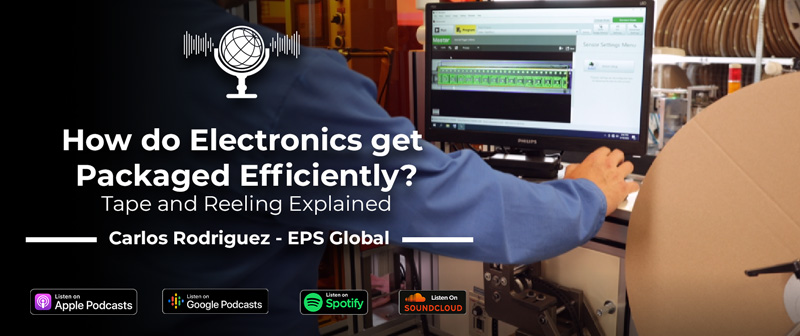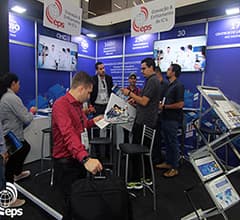Home > News & Blog > How do Electronics get Packaged Efficiently?
How do Electronics get Packaged Efficiently?

We rely heavily on electronics to power the products we use on a daily basis from our phones, TVs, laptops, home appliances, and especially our cars. The rapid evolution of connectivity in the automotive industry has led to a fundamental shift in the way we build and buy vehicles.
Where once there was steel and pistons, we now have carbon fiber and electronic chips connected to the IoT. We expect that our car will sync seamlessly with our phone, and give us directions to our destinations.
The intelligence source behind all of this is electronic devices or chips that are placed onto circuit boards on assembly lines across the globe in the manufacture of these products we all know and love. But most of us know little about what goes on behind the scenes.
How do electronics get packaged for efficient assembly into our most coveted devices?
What is tape and reeling?
Tape and Reel is the process of our packaging electronic components into individual pockets of carrier tape. The components are sealed with heat or pressure cover tape. It can be any electronic components, electromechanical, and even metal parts. Once the parts are put into the carry tape, this standard carrier tape goes around a standard plastic reel for loading into SMT lines.
What industries require tape and reeling?
Most electronics manufacturing industries that have SMT lines require tape and reel, for example the automotive industry, white label manufacturers, or industrial.
What are the benefits of components on tape vs trays?
The real estate around SMT lines is very expensive, and the optimum way to load components at the side of the SMT line is on feeders which take reels. The reason is that a reel width could be 24mm, whereas the tray length could be 150mm. So if you try to load your components directly from the tray, they won’t load as quickly as from reels, but they take up much more feeder spaces. The whole idea is to be able to compact your feeders so that when you present the components in reels, they take up much less space.
What is SMT?
SMT (Surface Mount Technology) means that electronic components are assembled with automated machines that place components directly onto the surface of the PCB instead of being soldered underneath. So when it comes to electronic assembly, SMT is the most efficient and frequently used process in the industry.
If I have older date code components that I’ve held in storage and they might be packaged loose, in trays, or in bags, can I package these onto Tape and Reel?
Yes, but first we need to check the components. We need to check the humidity indicator to find out if the components need to be baked. Once we find that out, we measure the geometry of the component and then we can do the taping and the reeling. It doesn't really matter how you get the components to us, we can provide the Tape and Reel service or the complete service if it's required.
Why is checking the humidity indicator of components recommended before packaging components?
If the J-STD-033B certified humidity indicator indicates that the components have been exposed to excess moisture, it is recommended that the components are baked in a software controlled oven to remove moisture at a controlled rate to prevent on components deforming during reflow.
What components can be taped and reeled?
In addition to electronic components, we can package metal parts, connectors, relays, essentially any component that needs to go into the SMT line, up 72mm wide and 15mm deep.
What are the dimensions of the reels?
We tape and reel components on to 13” reels up to 15” plastic reels.
How important is precision when manufacturing carrier tape?
Usually we follow the customer needs and they tell us the way they want the part to be in the reel according to the process they're going to use when it’s mounted to the SMT line, when it comes to is custom parts we will follow what the customer needs, and that's usually how we decide and determine the way the component is going to be put into the reel.
What is 3D coplanarity checking?
This process involves checking the pins on a component to ensure that the pins are not bent. Pins need to be in the exact right position when these components go into the PCB to ensure correct contact.
If I send my components to you for taping and reeling, how long do I have to wait to get them back from you on the reels?
For standard components it can be as quick as 24 hours. When it’s a custom sized part, it takes us between 2 to 4 weeks to the deliver samples.
How does taping and reeling my components speed up my manufacturing process?
The real estate around SMT lines is very expensive, and the optimum way to load components at the side of the SMT line is on feeders which take reels. The reason is that a reel width could be 24mm, whereas the tray length could be 150mm.So if you try to load your components directly from the tray, they won’t load as quickly as from reels, but they take up much more feeder spaces. The whole idea is to be able to compact your feeders so that when you present the components in reels, they take up much less space.
Do you sell carrier tape for non-standard sized or shaped components?
We also sell carrier tape, standard carrier tape, and custom carrier tape.
Do you have semiconductors you need programmed?
Outsource your IC programming to EPS Global and remove the complexity and considerable time burden of programming from in-circuit test. This will allow you to introduce increased efficiencies on your production line and cost savings to your organization.
We are strategically located in all major automotive electronic clusters worldwide. Our state-of-the-art, fully automated systems will program, 3D coplanarity check, laser mark and tape & reel your product and we can guarantee rapid delivery to help you meet your production deadlines.













